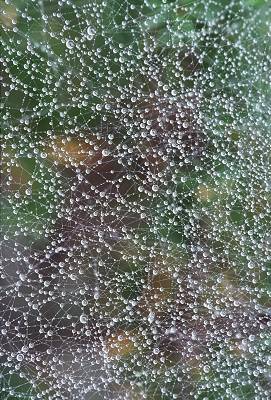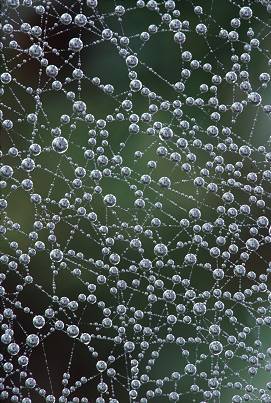 You have to get up early in the morning to catch dew on most things, but especially early when tracking down dew covered spider webs.
You have to get up early in the morning to catch dew on most things, but especially early when tracking down dew covered spider webs.
Spider webs are incredibly fragile, yet their construction and structure is the strongest of all structures in the world, even manmade. Inch for inch a spider web is stronger than steel, yet they are exceptionally elastic, stretching more than 40% of their length.
Yet, the slightest wind, heavy rain storm, or human crossing a spider web path can destroy it. For a nature photographer, finding the precious preserved spider web covered with dew is a combination of luck, weather, and planning.
Brent spotted a sheet web in the middle of the city, in a vacant lot covered with scrub and grasses. When he arrived early in the morning, luck was with him as the dew of the morning and light misting rains from the evening had collected water drops across the entire surface of the web.
Photographing spider webs requires absolute stillness. If you move, air currents caused by your movements and the heat of your body can shake or shatter the web. As the sun rises, the warmth on the ground causes the wind to rise, bringing more movement and vibration to fight against as you work with slow shutter speeds. Add dew and water droplets on a spider web and any such motion or current can shake all your sparkling jewels away.
The dew will also evaporate quickly with warming temperatures, so you are restrained to photographing early in the morning and in the short window of time between damp and dry.
Luckily, the fall morning remained cool. Brent was able to work the web for a while, moving slowly around with his 200mm lens, giving him working space to keep back from the web but magnification to fill the frame with the droplets.
Spiders aren’t very particular about where they build their webs, aiming for the flight zone of their flying food. Brent battled with the city homes and buildings in the background, struggling to find the magic background that would not distract from the dew-covered web, but also might enhance it.
He tried several positions. One was fairly straight on to the web, and brown, green, and yellow scrubs seem to add some color and depth to the web. Then he moved higher, watching the surface of the web, keeping a careful eye to maintain the camera’s film plane parallel with the plane of the web to get the most web structure and droplets in focus.
 Rising up a little with the tripod gave him the non-descript soft green background he sought. Nothing to distract. He added the 1.4x teleconverter, increasing the magnification and narrowing the background. Holding his breath, he snapped off five or six shots. He played with aperture and shutter, increasing the depth of field on the web but controlling it on the background.
Rising up a little with the tripod gave him the non-descript soft green background he sought. Nothing to distract. He added the 1.4x teleconverter, increasing the magnification and narrowing the background. Holding his breath, he snapped off five or six shots. He played with aperture and shutter, increasing the depth of field on the web but controlling it on the background.
After a while, he decided to add some sparkle to the dew drops with flash. Setting the flash to provide some fill flash, he added a few more spider web images.
Later, on the light table, we examined the collection of dew-covered spider web images. The photographs using the flash were okay, but just okay. They didn’t jump off the light table and scream “AMAZING”. The images with the soft green and yellow background were okay, and fairly interesting, but the image that caught our breath was the one using natural light, zoomed in close to the web so you could feel the fragility, every drop hanging, waiting to drop. This was the magical image.
 What makes this image magic? Its tension. Its beauty. Its simplicity. You know immediately what it is and yet you wonder what it is and how it was done.
What makes this image magic? Its tension. Its beauty. Its simplicity. You know immediately what it is and yet you wonder what it is and how it was done.
For a moment, it reminds you of the stars and planets in the sky traced by the ancients into bulls, horses, gods, and demons. Then you think beads, beaded fabric and lace, all interconnected. Each drop appears like a lens, and you lean in to see what views can be seen through them.
And you wonder. What part of this is real and what part is created? The droplets are so uniform, you wonder if they are there by plan. Slowly, you begin to wonder about the creature that made such a structure.
As with every powerful image, it holds your imagination.
For Brent, well, it was just another morning walk around the neighborhood, looking for spider webs to photograph.
Wonders of Spider Silk
Called one of the wonders of the natural world, spider silk fascinates us. With all our technology over the past 100 years, are still unable to reproduce a substance that is tough, stronger and more flexible than spider silk, the material spiders issue to make spider webs.
Here are some amazing facts and resources to learn more about spider webs and spider silk:
- The largest orb-webs come from spun spiders in the genus Nephila which may be 2 meters/6 ft in diameter, capable of catching small birds and bats.
- The largest webs are built by communal spiders, Ixeuticus socialis in Australia that may be 1.2 meter wide and 3.7 meters long (12×4 ft).
- There are billions of kilometers of spider silk spread across the globe.
- Author Paul Hillyard says in his book, The Book on Spiders
: “For an equal diameter, spider silk is stronger than steel and about as strong as nylon. It is, however much more resilient and can stretch several times before breaking – it is twice as elastic as nylon and more difficult to break than rubber.”
- Some fishing spiders (Dolomedes) can stay underwater for 45 minutes or more, using air bubbles stored on their abdomens, swimming underwater to attack their food, usually insects and small fish.
- Spider silk is able to stretch up to 40% of its length without breaking.
- Many spiders make a “dry” silk and a sticky silk. Spiders use dry silk to create structural frameworks for their webs, particularly evident with orb weavers. Between these radial spokes, the spider strings the sticky silk that ensnares any prey unfortunate enough to venture too close.
- Spitting spiders spit a formula of gluey venom at prey up to 3/8 of an inch (10mm) away. The glue holds the prey, while the venom paralyzes it.
- Amazon.com lists over 1700 books on spiders.
- Some spiders use silk to “fly”, allowing itself to be caught by the breeze and lifted up holding onto the end of the thread. Spiders can travel huge distances. Research records spiders over 14,000 feet/4.500 meters above sea level and in the middle of the ocean 1,500 km/1,000 miles from the nearest land.
- Spiders can live without food and water for long periods of time.